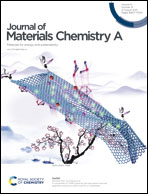Directing the deposition of lithium metal to the inner concave surface of graphitic carbon tubes to enable lithium-metal batteries†
Abstract
Selective deposition of lithium into a carbonaceous host is considered an effective strategy to prevent the growth of lithium metal dendrities. However, selective deposition of lithium metal into the inner spaces of a hollow carbonaceous host without nucleation seeds remains challenging. Herein, selective deposition of lithium metal is introduced by utilizing the difference in the nucleation barrier of lithium on the inner and outer surface of graphitic tubes. In situ transmission electron microscopy data indicated that uniform deposition of lithium metal into the hollow surface of graphite tubes occurred in the absence of electrolyte, and continued until the tube was fully filled. To increase the amount of lithium that can be accommodated, we contrived a novel method for preparing supersized graphite carbon tubes (S-GCTs) and demonstrated the relationship between morphology and electrochemical performance. Electrochemical study proved that the S-GCTs exhibited high coulombic efficiency (99.3% over 350 cycles) and long-running lifespan (>1200 h) with a low overpotential (<13 mV). The volumetric capacity of S-GCT reached 1.33 A h L−1, which is superior to that obtained in previous work. The fundamental understanding of how to control Li deposition demonstrated in this work will provide new insight for the rational design of lithium metal batteries.



 Please wait while we load your content...
Please wait while we load your content...